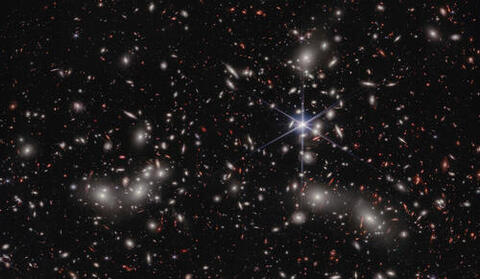Astronomers take a deeper, detailed look at a distant galaxy ‘megacluster’

Say cheese, Pandora.
An international team of astronomers, including researchers from Yale, has unveiled the latest deep field image from NASA’s James Webb Space Telescope (JWST): an unprecedented look at the region of space known as Pandora’s Cluster, with never-before-seen details of three galaxy clusters coming together to form a megacluster.
Pandora’s Cluster, named for the Greek myth, is located four billion light years from Earth. Astronomers often target it in observational surveys because of its ability to magnify much more distant galaxies behind it — a phenomenon called gravitational lensing. It allows researchers to peer at features from the early universe that would otherwise be impossible to observe.
The image had a profound impact on me, both in terms of its beauty and its scientific potential.
Pieter van Dokkum, Sol Goldman Family Professor of Astronomy
Previous images from the Hubble Space Telescope looked only at the Pandora Cluster’s central core. The new image stitches together four JWST snapshots into one panoramic image that displays roughly 50,000 sources of near-infrared light.
“The image had a profound impact on me, both in terms of its beauty and its scientific potential,” said Pieter van Dokkum, the Sol Goldman Family Professor of Astronomy and professor of physics in Yale’s Faculty of Arts and Sciences.
“Along with the rest of the world, I had already seen what JWST could do, and I figured the new image would look similar to the first data unveiled back in July,” van Dokkum said. “However, the wider area and the much greater depth of the new image turned out to be yet another leap forward.”
The researchers used Webb’s Near-Infrared Camera (NIRCam) to capture Pandora’s Cluster with exposures lasting four-to-six hours, for a total of 30 hours of observing time. Later this year, the researchers will use Webb’s Near-Infrared Spectrograph (NIRSpec) to obtain precise distance measurements and other detailed information about the lensed galaxies’ compositions — providing new insights into the early era of galaxy assembly and evolution.
“JWST was built to explore the earliest epochs of the formation of black holes and galaxies,” van Dokkum said. “To do that, one has to stare at the same area of sky for a long time, to find the very faintest and earliest objects that JWST can detect.”
Van Dokkum is a team member and advisory committee member for the Ultradeep NIRSpec and NIRCam ObserVations before the Epoch of Reionization (UNCOVER) program, which worked with Webb instruments to produce the new image. Marla Geha, a professor of astronomy and physics at Yale, also is part of the UNCOVER program.
As UNCOVER progresses, Yale graduate students also will begin working with the JWST data.
“With UNCOVER, we decided not to wait until later years of JWST’s mission, even though we did not know yet how the telescope would perform,” van Dokkum said. “Fortunately, JWST is performing flawlessly, and is even more sensitive than we had expected.”
UNCOVER’s principal investigators for the project are Rachel Bezanson of the University of Pittsburgh and Ivo Labbe of the Swinburne University of Technology in Australia.
Story written by Jim Shelton, YaleNews.
